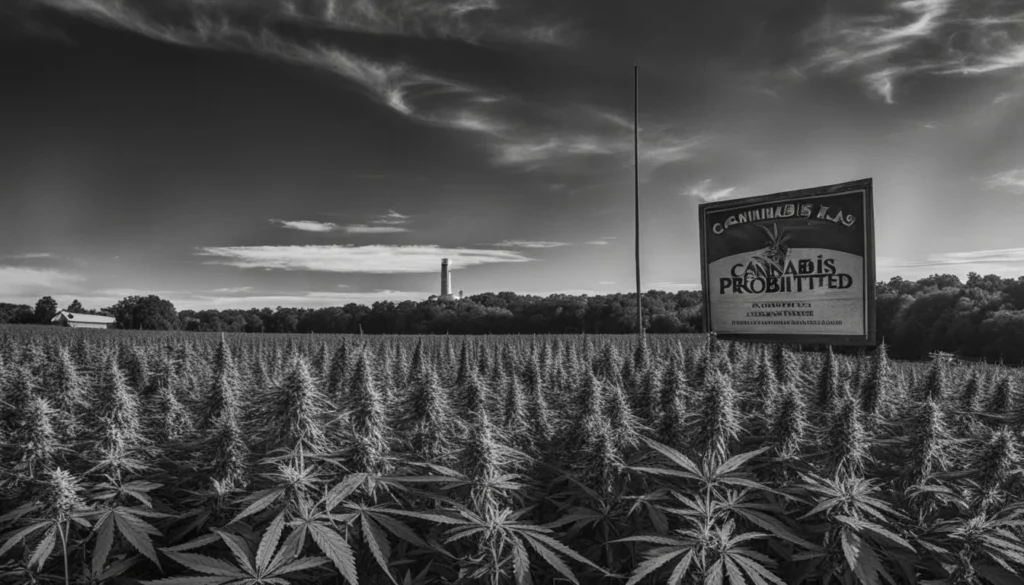Welcome to a journey that unravels the fascinating history of weed, taking you on a global odyssey that spans centuries. From ancient civilizations to modern-day debates, the story of weed is one that has shaped human culture and society in profound ways.
For at least 3000 years, cannabis cultivation has been valued for its diverse uses, ranging from fiber and rope to food, medicine, and its psychoactive properties. As we delve into this intricate narrative, we will explore the ancient uses of cannabis, the global spread of this remarkable plant, the early restrictions it faced, and its medicinal significance throughout history.
Join us as we uncover the captivating tale of weed, shedding light on its past, present, and future in the ever-evolving landscape of cannabis.

Where Does Weed Come From?
A group of biologists and other scientists said humans began growing cannabis about 12,000 years ago not just for food, but also for hemp and, yes, probably to get high.
A new study suggests that the cannabis sativa plant was first domesticated in East Asia and that all existing breeds come from an “ancestral gene pool” represented by wild and cultivated varieties growing in China today. Kelsey McClellan for The New York Times
Ancient Uses of Cannabis
Ancient civilizations have a rich history of utilizing cannabis for various purposes. Let’s delve into the ancient cultures of India, China, and Korea to explore their fascinating relationship with this versatile plant.
Ancient India: Cannabis in Food and Drink
In ancient India, cannabis, known as “bhang,” has been used for centuries in food and drink. Its use dates back to 1000 BC and is deeply rooted in Hindu practice and culture. Bhang is often consumed during religious ceremonies and festivals, believed to bring spiritual upliftment and a sense of well-being.
Ancient China: Hemp for Clothes, Ropes, and Paper
China, too, has a long history of cannabis use, primarily for its versatile fibers. Hemp, a variety of cannabis, was cultivated for making clothes, ropes, and paper as early as the Neolithic Age. Its robust qualities and sustainable nature made it an invaluable resource in ancient Chinese civilization.
Ancient Korea: Cannabis as an Important Crop
Ancient Korea also had a deep connection with cannabis. The historical evidence suggests that cannabis, particularly hemp, was cultivated as an important crop in Korea as early as 3000 BC. Hemp fabric dating back to this era has been discovered, showcasing the significance of cannabis in the region’s textile industry.
Global Spread of Cannabis
Cannabis, with its rich history and cultural significance, has spread across the globe, finding its way into various regions and societies. The introduction of cannabis in different parts of the world has shaped its diverse uses and applications.
Cannabis in the Islamic World
In the Islamic world, cannabis became intertwined with religious and cultural practices. Historically, cannabis was commonly used in the Arab world and Middle East. The Arab traders and travelers who traversed across regions played a pivotal role in spreading cannabis throughout the Islamic world.
Cannabis in the Arab World
The Arab world embraced the use of cannabis, particularly in the form of hashish. The resinous form of cannabis, hashish, gained popularity and became an integral part of social and cultural gatherings. It was used for relaxation, spiritual experiences, and as a source of inspiration for poetry and music.
Cannabis in Africa
The introduction of cannabis to Africa can be attributed to the influence of Hindu travelers from India. They brought cannabis plants and seeds to different parts of the African continent, where it found a variety of uses. In Africa, cannabis was utilized for medicinal purposes, religious ceremonies, and even as a source of dietary fiber and nutrients.
The global spread of cannabis highlights its adaptability and the influence of different cultures on its usage. As cannabis journeys through time and across continents, its significance continues to evolve, shaping societies and inspiring ongoing discussions on its legalization and regulation.
Early Restrictions on Weed
In the early history of cannabis, various regions around the world began imposing restrictions on its use and cultivation. These early restrictions would shape the perception and legality of cannabis for centuries to come.
In the Middle Ages, cannabis bans were already in place in certain jurisdictions. In the 1300s, the emir of the Joneima in Arabia prohibited cannabis use, marking one of the earliest recorded instances of cannabis restrictions. In 1787, King Andrianampoinimerina of Madagascar banned cannabis throughout his kingdom, signaling the widespread concern over its use.
During the 19th century, cannabis was subject to bans in Brazil and British Mauritius. The Brazilian government banned cannabis due to concerns over its use by laborers, while British Mauritius implemented restrictions to address similar issues. In British India, cannabis regulations were also being considered in the 19th century, although it wasn’t until the 20th century that actual laws were passed.
These early restrictions on cannabis set the stage for the evolving legal landscape surrounding the plant. Understanding the historical context of these bans helps shed light on the complex relationship between society and cannabis throughout the centuries.

Medicinal Uses of Cannabis
The history of medicinal cannabis dates back centuries and spans across various cultures. Ancient civilizations, such as Egypt, Greece, and Rome, recognized the therapeutic properties of cannabis and utilized it for medical purposes. Emperor Shen Neng of China, as early as 2737 BC, prescribed marijuana tea for various ailments.
In modern medicine, cannabis has been found to be effective in relieving pain, reducing nausea, stimulating appetite, and treating various medical conditions. It has shown promising results in managing chronic pain, spasticity associated with multiple sclerosis, and the side effects of chemotherapy.
Ancient Medicine
- In ancient Egypt, cannabis was used to treat hemorrhoids, glaucoma, and inflammation.
- In ancient Greece, it was used for pain relief and to dress wounds.
- In ancient Rome, cannabis was used as anesthesia and to treat earaches and inflammation.
Modern Medicine
- In modern medicine, cannabis-based medications, such as Sativex and Epidiolex, have been developed and approved for certain conditions.
- Cannabis is being studied for its potential in treating epilepsy, multiple sclerosis, Parkinson’s disease, and even certain forms of cancer.
- However, more research is needed to fully understand its effectiveness and potential side effects.
As the medical community continues to explore the therapeutic benefits of cannabis, ongoing research and advancements are expected to further expand its applications in modern medicine.
The Discovery of the Endocannabinoid System
In 1964, scientists made a groundbreaking discovery that would shed light on the profound effects of cannabis on the human body. They successfully determined the structure of THC, the primary psychoactive compound in cannabis, leading to significant advancements in understanding the plant’s impact on our physiology.
This pivotal discovery opened the door to the exploration of the endocannabinoid system (ECS), a complex signaling system within our bodies. The ECS plays a crucial role in regulating various physiological processes, including mood, pain sensation, appetite, and immune function. It is comprised of cannabinoid receptors, endocannabinoids (which are naturally occurring compounds similar to the cannabinoids found in cannabis), and enzymes that synthesize and break down these endocannabinoids.
The THC’s Impact on the Body
When THC enters the body, it interacts with the cannabinoid receptors of the ECS, primarily the CB1 and CB2 receptors. This interaction triggers a cascade of chemical reactions that result in the psychoactive effects associated with cannabis use, such as euphoria, relaxation, increased appetite, and altered sensory perception.
Scientific Advancements in Understanding Cannabis
The discovery of the endocannabinoid system has revolutionized our understanding of cannabis and its effects on the human body. Since then, scientists have made significant strides in unraveling the intricate mechanisms through which cannabis compounds interact with our physiology. They have identified additional cannabinoids, such as CBD, and have explored their therapeutic potential in treating various medical conditions.
As research continues to unfold, scientists are uncovering new insights into the potential benefits and risks of cannabis use. This ongoing exploration of the endocannabinoid system and the scientific advancements in understanding cannabis pave the way for further discoveries, potentially leading to new treatments and innovations in the field of medicine.
The History of Cannabis in Montana
Montana has seen significant developments in the field of cannabis, particularly in terms of legalization and the establishment of a medical marijuana program. In 2004, Montana became one of the states to legalize the medical use of marijuana through a referendum vote. This decision allowed patients access to cannabis for therapeutic purposes, offering relief to individuals suffering from various medical conditions.
Montana’s medical marijuana program enables patients to grow their own plants or designate a caregiver to cultivate on their behalf. This initiative has resulted in a steady increase in patient enrollment, with projections suggesting that the number of medical marijuana licenses could reach 50,000 by 2023. As the demand for medical cannabis continues to grow, Montana has witnessed the emergence of different business models to accommodate this demand. From growing cooperatives to storefront distribution sites, the cannabis industry in Montana is expanding to meet the needs of patients.
The Impact of Cannabis Legalization in Montana
The legalization of cannabis in Montana has had a significant impact on various aspects of society. From an economic standpoint, the cannabis industry has contributed to job creation, with opportunities ranging from cultivation and production to retail and ancillary services. Additionally, the legalization of cannabis has generated tax revenue for the state, which can be allocated towards public services, healthcare, and education.
Montana’s experience with cannabis legalization has also prompted discussions surrounding social equity. Efforts are being made to ensure that individuals disproportionately affected by the war on drugs have access to opportunities within the cannabis industry. This includes initiatives to reduce barriers to entry for minority-owned businesses and promoting diversity in the workforce.
In conclusion, the history of cannabis in Montana is characterized by the legalization of medical marijuana and the subsequent growth of the cannabis industry. As the state continues to navigate the complexities of cannabis policy and regulation, the future of cannabis in Montana holds both opportunities and challenges. The ongoing evolution of the industry, coupled with the benefits experienced by patients and the state, highlights the significant role that cannabis plays in Montana’s healthcare and economy.
The Global Impact of Cannabis Legalization
As cannabis legalization continues to sweep across the globe, the impact of these reforms is far-reaching. Countries and states are adopting different approaches, from medical cannabis programs to full legalization for recreational use. These changes have sparked a global trend towards cannabis liberalization, with increasing acceptance and demand for cannabis products.
One of the major impacts of cannabis legalization is economic growth. The cannabis industry has emerged as a significant contributor to local and national economies, creating jobs and generating tax revenue. This growth is fueled by the demand for cannabis products, including medical marijuana, edibles, concentrates, and more. The cannabis market is projected to continue expanding as more jurisdictions embrace legalization and consumers have access to a wider range of cannabis products.
Beyond economic benefits, cannabis reform has also led to shifts in law enforcement priorities. With the legalization of cannabis, law enforcement resources can be redirected towards more pressing issues, reducing the burden on the criminal justice system. This shift allows for a more nuanced and targeted approach to drug policy, focusing on public health and harm reduction rather than punitive measures.
The Impact of Cannabis Reforms:
- Creation of jobs and economic growth
- Generation of tax revenue
- Redirection of law enforcement resources
- Focus on public health and harm reduction
While cannabis legalization initiatives have garnered support for their potential benefits, it is important to consider the potential risks and challenges that accompany these reforms. Public health concerns, such as the potential for addiction and mental health implications, require ongoing research and regulation. Additionally, the impact of cannabis on road safety and underage use needs to be carefully addressed through education and appropriate regulations.
The global cannabis trends indicate a shifting landscape that reflects changing societal attitudes towards cannabis. As more countries and states continue to explore and implement cannabis reforms, it is evident that the future of cannabis is still evolving. Continued research, responsible regulation, and public discourse will shape the path forward for this versatile plant.
The Controversies Surrounding Cannabis
Despite the growing acceptance and legalization of cannabis, it continues to be surrounded by controversies, with various concerns and debates shaping the public perception of this versatile plant.
Public Perception of Cannabis
Public perception of cannabis has evolved over time. While it was once stigmatized as a dangerous drug, attitudes towards cannabis have shifted, with many recognizing its potential medical benefits and advocating for its legalization. However, there are still segments of society that hold negative views on cannabis, viewing it as a gateway drug or associating it with criminal behavior.
Concerns about Cannabis Use
One of the main concerns surrounding cannabis use is the potential for addiction. While research suggests that the majority of cannabis users do not develop an addiction, some individuals may experience dependence or use the drug in a manner that negatively impacts their daily lives. Additionally, there are concerns about the potential mental health implications of cannabis use, particularly in individuals who are predisposed to conditions such as schizophrenia or anxiety disorders.
- Impaired driving: Another significant concern is impaired driving under the influence of cannabis. The psychoactive compound THC can impair motor skills, reaction time, and judgment, increasing the risk of accidents on the road.
- Underage use: With the legalization of cannabis in some regions, there is an increased concern about underage use. Critics argue that increased availability may make it easier for minors to access and consume cannabis, potentially affecting their cognitive development and overall well-being.
Legalization Debates
The ongoing debates surrounding cannabis legalization continue to shape legislation and policies worldwide. Proponents argue that legalization can lead to economic growth, job creation, and tax revenue generation, as well as allowing for regulation and quality control of cannabis products. Critics, on the other hand, express concerns about the potential negative social and health consequences, the risk of increased drug abuse, and the impact on public safety.
The Future of Cannabis
The cannabis industry is poised for a bright future as research and development efforts continue to uncover new potential applications for this versatile plant. With the expanding legalization and acceptance of cannabis, the industry is experiencing significant growth and innovation. From medical treatments to industrial uses, the possibilities for cannabis are vast and exciting.
Research and Development
Extensive research and development efforts are underway to explore the potential benefits and applications of cannabis. Scientists and experts are delving into the plant’s chemical compounds and their effects on the human body. This research is leading to the development of new medicines, therapies, and treatments for a wide range of conditions. Additionally, ongoing studies are focusing on the cultivation and extraction techniques to optimize the plant’s potency and efficiency.
Potential Applications
Cannabis has the potential to revolutionize various industries. The plant’s fibers can be used to create sustainable textiles, bioplastics, and building materials, contributing to a greener and more eco-friendly future. Furthermore, cannabis-derived products are finding their way into the beauty and wellness industries, with CBD-infused skincare and wellness products gaining popularity.
As more countries and states embrace cannabis reform, the global landscape of the industry will continue to evolve. The future of cannabis holds immense possibilities, and with ongoing research and development, we can expect to witness groundbreaking discoveries and advancements. The potential applications of cannabis are diverse, and its impact on various sectors will continue to transform industries for years to come.

- Medical treatments and therapies
- Sustainable textiles and materials
- Beauty and wellness products
- Industrial and agricultural applications
Conclusion
The story of cannabis is a captivating tale that has unfolded over centuries and across continents. From its ancient uses in various cultures to its global spread and the current movement towards legalization, cannabis has left an indelible mark on human history. Throughout its journey, cannabis has been valued for its versatility, serving as a source of fiber, medicine, and even spiritual connection.
As we have explored in this article, ancient civilizations such as India, China, and Korea embraced cannabis for its many benefits. The global spread of cannabis was fueled by trade routes, cultural exchanges, and colonization. However, with the rise of restrictions and prohibitions in different regions, the perception of cannabis shifted dramatically.
Today, the conversation surrounding cannabis is undergoing a significant transformation. The medicinal uses of cannabis are being rediscovered, and the potential benefits are being recognized by an increasing number of countries and states. While controversies and concerns persist, the future of cannabis holds promise for continued research, innovation, and exploration.
As society continues to navigate the complexities of cannabis policy and regulation, the story of cannabis continues to evolve. Whether it be the development of novel medical treatments, advancements in cultivation techniques, or the societal impacts of cannabis reforms, the future of this versatile plant remains to be seen. The story of cannabis is far from over, and its impact on humanity will continue to unfold in the years to come.




